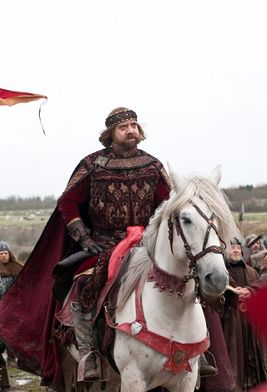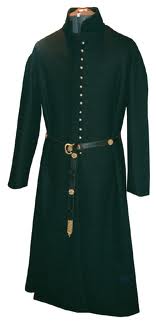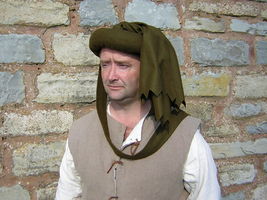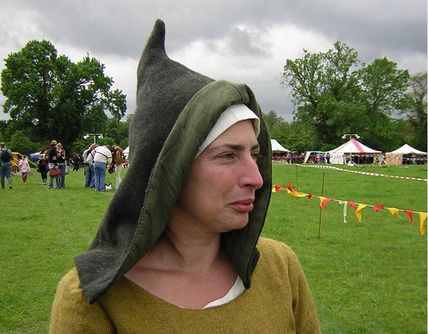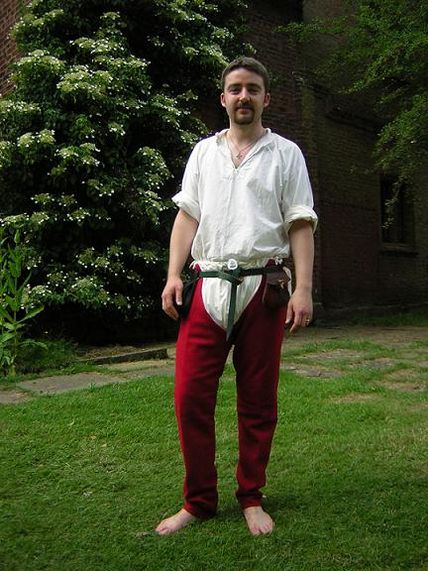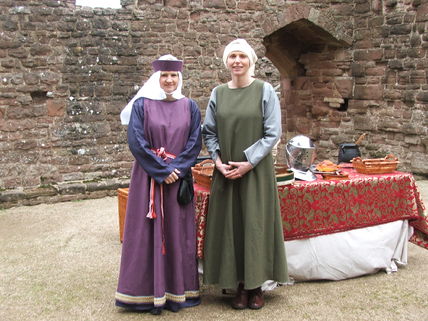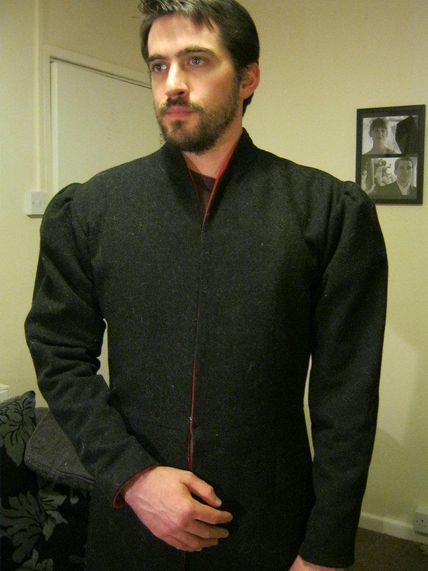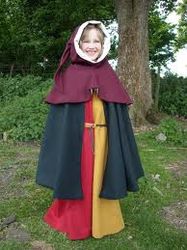The Marches look and feel
Overview
The Marches draws strongly on English history from the 12th century through to the War of the Roses for costume, weaponry and armour.
The costume of the Marches has a 'solidity' to it, a worn, lived in look that contrasts with its neighbour Dawn's high romance, gleaming plate and vivid hues. The Marches is Kenneth Brannagh’s Henry V rather than Laurence Olivier’s.
Breakdown
Influences
Wars of the Roses England, Rangers of Ithilien (Beaters), Cadfael (Monks and Landskeepers).
Materials
Wool, calico, linen, leather.
Colours
Plain flat colours, mostly the soft colours of natural dyes or unbleached cloth. The palette is autumnal suggesting natural dull blues, greys, browns/ rusts, mustards and greens, dull reds etc. especially at the lower end of the social scale. Wealthier Marchers may use deeper, brighter shades.
Clothing
Marchers favour simple hoods, hose and plain clothes. Workers might wear sleeveless jerkins and leather trousers. Wealthier characters might wear finer robes but wool not silk. Headwear is common, either a simple cap, or something like a hood and liripipe or plain chaperon.
Ladies generally wear shifts and kirtles. The look of the dresses is long, lean and smooth and laced to fit. Back lacing shows higher status and gives a better line. Side lacing is more usual.
Hose, either joined or split, are acceptable worn with braies and a long shirt. If you wear split hose you will require a longer shirt than a 20th century one - as it is normal for the shirt to hang out front and rear (thus covering one’s embarrassment). Shirts are an extremely simple untailored cut, full in the body and sleeve, possibly gathered at neck and wrist.
Doublets are common but should be short and simple, not the fancy slashed doublets of the Tudor period and later. Tunics are generally woollen (or linen in summer) and come down to somewhere between mid-thigh and the knee. Woollen livery coats in the household colours are often worn over armour
Marchers have no pockets so a pouch is invaluable – bollock or kidney pouches
or leather bags are perfect. Belts are often very long, wrapped round,
looped at the front and left to dangle.
Both male and female monks wear traditional plain monks habit either in dark colours, or white with a dark scapula.
Armour
Padded or leather jacks are common for the poor with a harness of plate for richer individuals. Households often wear matching livery jackets, although simple sashes or badges are also used to denote afiliation.
Shields
Not common. Small metal bucklers are sometimes used.
Weapons
Bows are common. In hand-to-hand combat Marchers favour bills and other pole-arms. Two handed swords are common for richer characters in heavier armour, or warhammers, maces or poleaxes.
Feel
Gritty, solid, practical, superstitious, mud, blood, green fields, rural, iron.
Icons and important Images
Any Marcher who owns farmland is a member of a Household, albeit perhaps a Household of one, and any Marcher Household can declare a livery. Members of the Household wear the livery in some way – perhaps as a coat, or perhaps as a simple sash or badge. Stewards of a Household that alies to a more powerful Household usually retain their own livery, or combine it with the new Households’ colours in some way.
Poppets and other symbols of the land are commonplace. Gates and doors are traditionally decorated with woven bundles of grain on either side, the respect shown to the land prevents evil doers from entering. The hearth is where food taken from the land is prepared. It should always be kept clean and ideally be decorated with fresh cut flowers to prevent food cooked there causing a poison of the blood. Poor March Folk or those on campaign will make do with bundles of grass or common meadow flowers.
The symbol of the seed or apple and seed is a common representation of the soul and the cycle of rebirth. The crow and the rat are both images of ill-omen and bad luck.
Images
Marcher Household
A prosperous Marcher Household will wear often wear matching livery jackets, although simple sashes or badges are also used to denote afiliation. Padded jacks are common for the poor with a harness of plate for wealthier individuals.
Yeomen
Poor Yeomen may wear just a plain coloured padded jack or gambeson as their only armour. Wealthier Yeomen have jacks in their Household colours and mail or plate over the top if they have it.
Stewards and Wardens
The head of a Household, a Steward, wear richer colours, but wool not silk. Wealthy Marcher characters wear a full harness of plate in battle if they have it.
Beaters
Beaters are skilled trackers and gamekeepers. They watch the borders of the Marches. They are inspired by the classic British archers of the period mixed with the Rangers of Ithilien from Lord of the Rings.
Beaters usually wear lighter armour, either just a padded or leather jack or else a leather tunic like the ones worn by the Rangers in Lord of the Rings.
Marcher Costume
Marcher costume is in natural autumnal colours using plain fabrics like wool, calico and linen. Shirt and tunic is common for men, skirt and kirtle for women, headwear for both genders.
Robes of wool – either with a neck opening or opening all the way down the front in coat style. They are long, anywhere between knee length and full length.
Belts are often very long, wrapped round, looped at the front and left to dangle.
Hose, either joined or split, are acceptable. If you wear split hose you will require a longer shirt. Shirts are an extremely simple untailored cut, full in the body and sleeve, possibly gathered at neck and wrist.
Ladies generally wear shifts and kirtles. The look of the dresses is long, lean and smooth and laced to fit. Headwear is comomon, either a simple cap, or something like a liripipe or chaperon.
Doublets are common in the Marches, a snug-fitting buttoned jacket that is shaped and fitted to the body. It can be worn over the shirt or drawers or under another layer of clothing such as a gown, mantle, or overtunic.
Marcher doublets should be appropriate for the period and feel of the Nation. They are in simple autumnal colours. The fancy doublets that appear later in history, particularly anything with slashed sleeves or similar should be avoided for the Marches.
Monks and FrIars
Monks and friars wear similar robes. A simple brown cassock is acceptable but it can also be black or grey. A more complex arrangement with dark scapula over white undergarments is also excellent.
Landskeepers
Some landskeepers wear robes, similar to the monk, but waistcoat-shirt-and-hose, with rolled-up sleeves is a good alternartive.
Marcher Children
Marcher Weapons and Armour
Shields are uncommon in the Marches, the most common are small metal bucklers when they are used at all. Any historical weapons from the Hundred Years War and the War of the Roses are good, bollock daggers, axes, falchions, mauls, warhammers, poleaxes and bills.
